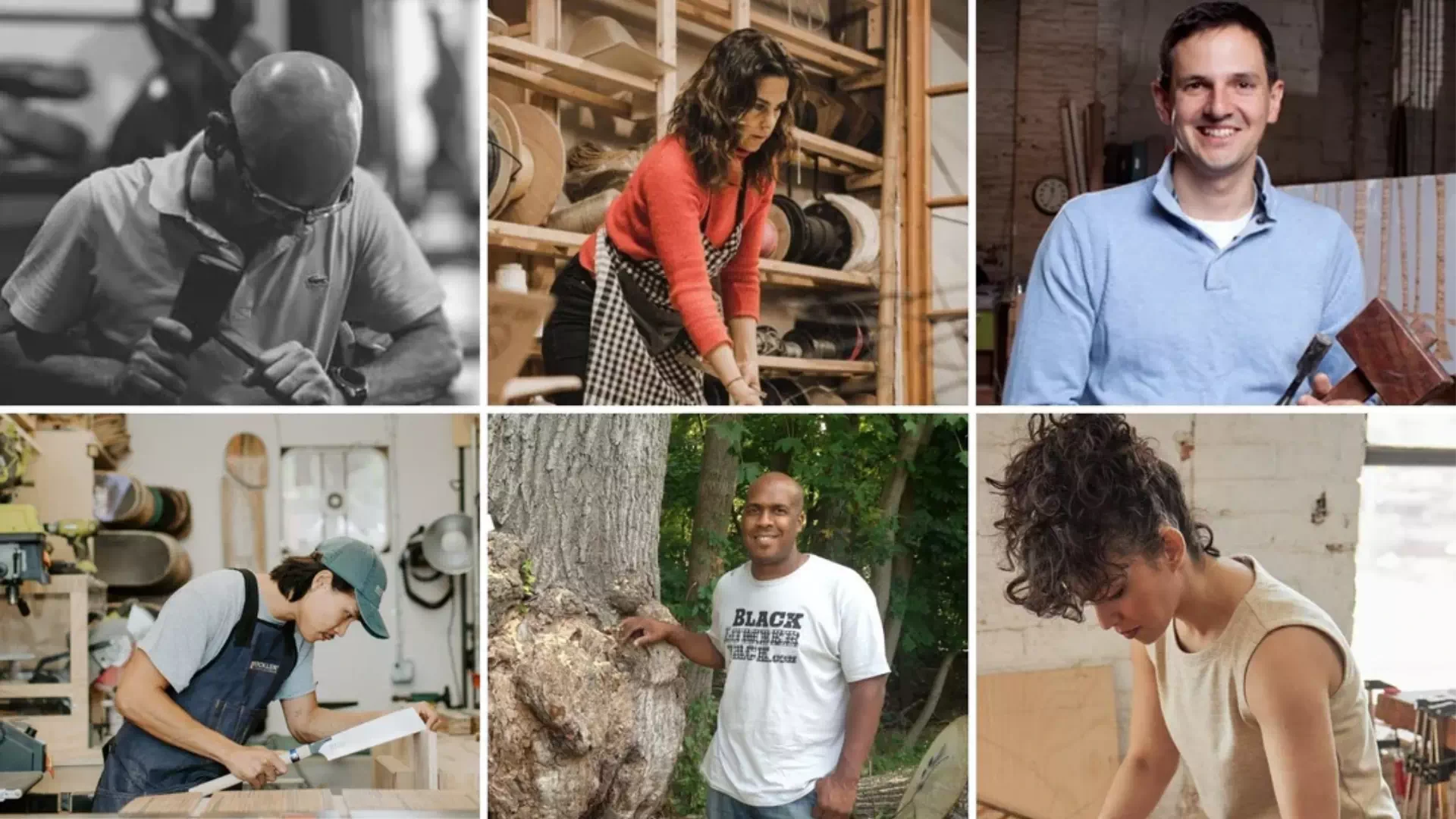
Artists Who Inspire Us
22-Sep-2021
Series > Reclaimed Wood: Beyond the Basics
Part 4. Artists Who Inspire Us
In the concluding article of our series Reclaimed Wood: Beyond the Basics, we’re excited to highlight six talented furniture-makers who demonstrate the immense range and potential of reclaimed wood in their designs.
These artisans inject their passion into each unique piece. The creativity which goes hand in hand with reclaimed wood furniture reflects the inherent idiosyncrasies of each board, resulting in distinct tables, chairs, cabinets and more.
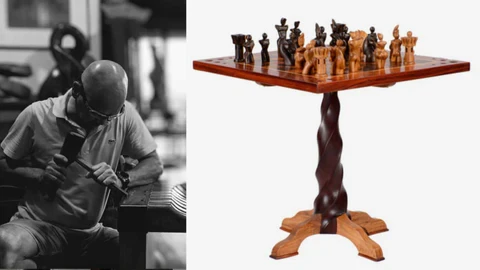
Tsekmeyt by Benji Reyes
Benji Reyes
Antipolo, Philippines
Thirty years ago, Benji Reyes bartered two bottles of gin for three 8’ x 8’ x 10’ posts lying in a demolished building, and began his journey as an artist. His creativity in both material acquisition and design have continued since. Functionality and style are key to Benji’s furniture; his distinctive designs are sculptural, built from a mix of woods, without nails or screws. They are meant for both use and contemplation.
In his creative process, Benji discovers the characteristics of various wood species while sculpting them into furniture. He highlights each type of wood’s strength, using different varieties for different elements of the piece. In his high back chair, “Rajah,” Benji combines balayong for the backrest and back leg; saray for the seat; yakal for the front legs; and iron woods for the stretchers. In another, “Tsekmeyt” (above), Benji crafts a chess table made of balayong, amboyna burl, saplungan, molava, and ipil woods, using seamless joinery. The range of Benji’s work stems from the many reclaimed woods that reflect the diverse, lush ecosystem of Antipolo and the Philippines.
benjireyes.com / @benjireyes
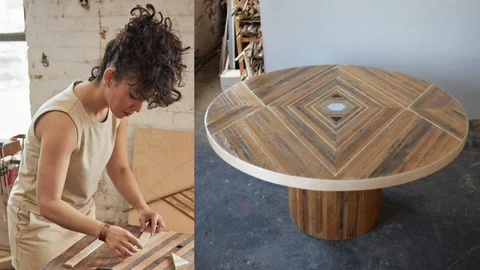
Tiffany Gomez
Bronx, New York
The signature quilt-like patterns of Tiffany Gomez’s work are practically hypnotic. She crafts table tops and headboards using primarily reclaimed lath, the slats of wood holding plaster to walls and supporting roof shingles and tiles in old buildings. In the Jana Dining Table (above), for example, the top is constructed of layers of multicolored lath into a round, modern shape. “The weathering of reclaimed wood is what inspires me most,” notes Tiffany. “I’m naturally drawn to the colors, patterns and textures that are present in the material. Those elements determine what each piece will ultimately become.” She has created close to a hundred furniture pieces using lath and “no two have ever been the same.”
Tiffany started using reclaimed wood in 2016 because it was the “sustainable thing to do.” Instead of perpetuating the continued felling of new trees, she focuses her attention on the plethora of salvaged wood to create her furniture. These pieces speak to the history and texture of the lath, and the creativity which reclaimed wood can bring to design.
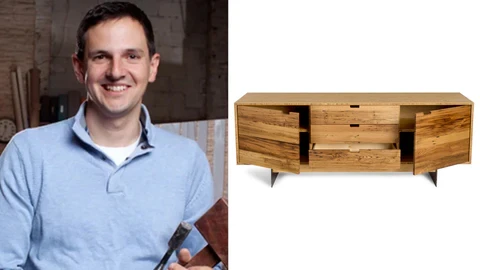
Iannone Design
Elmer, New Jersey
Founded by Michael Iannone, this eponymous furniture company is best known for its fantastic, narrative designs. With inlays depicting VW vans, gingko leaves, hummingbirds, and dandelions, each furniture piece expresses the natural world not only in its materials, but also in its composition. “Reclaimed wood,” Michael explains, “often has characteristics that lean towards a more rustic look -- nail holes, knots, worm holes -- so I'm often designing to balance those unique aspects with the more modern aesthetic of my work...The look of the wood -- color, grain, character -- is usually my primary concern.”
Michael's focus on reclaimed wood’s characteristics is shown in the Lancaster Credenza (above). The furniture piece is made of reclaimed chestnut and bamboo with blackened steel legs. Michael prioritizes the principles of good design and quality craftsmanship as a means of making furniture that is timeless and multigenerational.
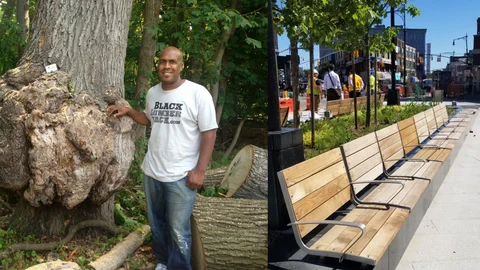
NYCitySlab
Yonkers, New York
Robert Rising’s first reclaimed wood project started when he built a house with his family and needed new furniture for the residence. “I would see these tree trunks dumped in the yard and then turned into firewood,” recalls Robert. He had the trunks cut, put a couple of pieces on eBay, and started his business, NYCitySlab.
Nowadays when looking for material, Robert focuses on “the stuff that has the biggest meaning and that gives it the longest life.” Rising’s William Wall Dining Table and Bench capture that kind of history. The table and bench are made from hundred-year-old lumber taken from 292 Fifth Avenue, a building once inhabited by William Wall, one of the first mayors of Williamsburg. The stories behind the wood give Robert’s furniture a character not easily found in new lumber. His pieces celebrate all parts of New York: from the Coney Island Boardwalk to Belmont Race Track to the now torn-down Blatt Building on Broadway, from Soho to Dumbo to South Street Seaport. NYCitySlab represents New York and all of its history.
nycityslab.com / @nycityslab
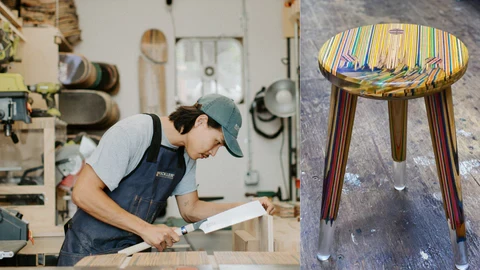
Woby Design
Los Angeles, California
Ben Paik’s approach to reclaimed wood is precise: he only deals in used skateboards. He first came to this material because it was free, only later realizing the potential of its bold colors. Ben injects those bright pigments across his work, whether it be the plywood-esc epoxied arm chair emblazoned with Woby Design on the backrest or a swirly rainbow stool made of stacks and stacks of broken skateboards (above).
Ben chronicles his colorful experiments on Youtube, showing his painstaking furniture creation process. In the end, Ben hopes his furniture is enjoyed and passed around. If not, buyers can remake and recycle his designs into something else, continuing the skateboards’ journeys.
woby.design / @wobydesign
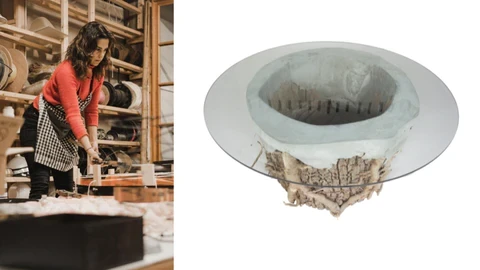
REDU NYC
Brooklyn, New York
Amber Lasciak’s mantra is “trash is a mentality.” Indeed, the only materials her company REDU NYC buys are tools and sometimes paint, which is mostly donated. Everything else -- wood, plastic, metal -- is taken from deconstructed buildings, maker workshops, and river bottoms. Amber describes REDU’s methodology as puzzling out how to suture a pile of unspecified, random wood fragments together. No 4’ x 4’s here!
One of the first pieces Amber created was from a 400-pound tree stump found on the side of the road in Connecticut. She bore a hole in the center, dipped it in cement, put a glass top on it, and the stump became a functional, reclaimed furniture piece. In the future, Amber hopes that we will “look at our own waste as a commodity.” Instead of construction sites and workshops gratefully giving away their scraps to places like REDU, Amber explains, they should be capitalizing on their wealth of material and its potential by selling these leftovers to artists for a second life. In that way, trash is only a mindset.
--
Each of these furniture-makers optimizes the full potential of reclaimed wood: they tap into its history, geography, color, and texture to craft one-of-a-kind furniture pieces. These artisans’ ingenuity with reclaimed wood offers a wide lens on the range of possibility in circular and regenerative furniture.
Read the other articles in the Reclaimed Wood: Beyond the Basics series.
